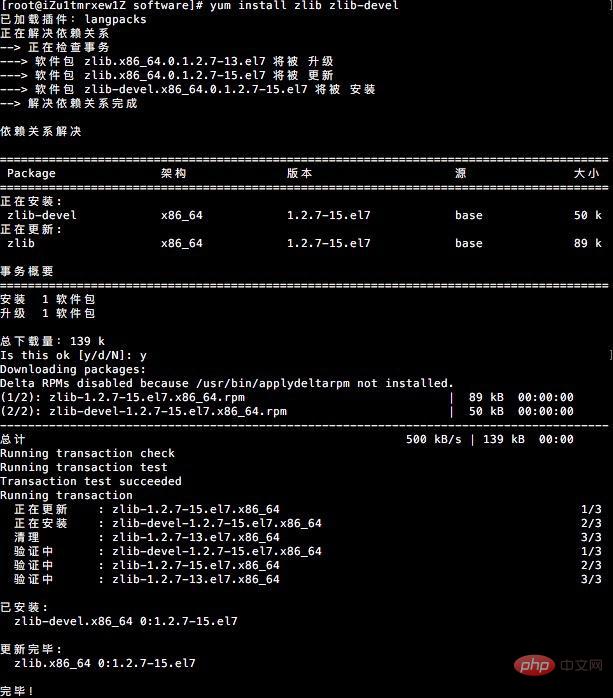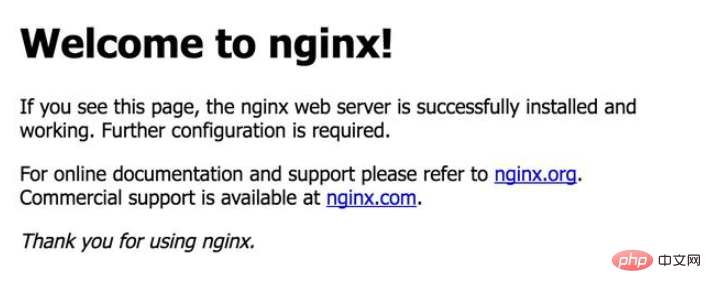How to install Nginx under Centos
nginx("engine x") is a lightweight http and reverse proxy server. Compared with apache, lighttpd, etc., it has the advantages of less memory, strong concurrency, and high stability. Its most common use is to provide reverse proxy services.
Under Linux, we need to download the nginx source code package and compile it manually instead of using package management tools such as yum and aptitude to install it. Because we need to configure nginx during compilation, we have to compile it manually, which also relies on some tools and library files.
First of all, you need to install the c language compilation environment, because nginx is written in c language. Usually most Linux will install gcc by default. If not, you can install it as follows.
Install make:
yum -y install gcc automake autoconf libtool make
Install g:
yum install gcc gcc-c
pcre library:
nginx requires pcre (perl compatible regular expression), because nginx’s rewrite module and The http core module will use pcre regular expression syntax. The download address is, we can also install it through yum.
yum install pcre pcre-devel

The above is the installed prompt.
zlib library:
The zlib library provides a compression algorithm, and the gzip algorithm is used in many places in nginx. Its download address is, and it can also be installed through yum.
yum install zlib zlib-devel

The above is the case where the package is not installed or is not the latest package.
openssl:
If the server provides a secure page in nginx, you need to use the openssl library. Its download address is, and it can also be installed through yum.
yum install openssl openssl-devel
Download nginx:
nginx source code package can be downloaded from the official website, the latest stable version is currently As of 1.10.1, there is also a development version available. The relevant commands are as follows:
wget
tar zxf nginx-1.10.1.tar.gz
cd nginx-1.10.1/
Install nginx:
Configuration is required before installation, which is also a common step for installing software under Linux. You can directly use the configure script for initial installation. If necessary, you can set switch options to enable the required functional modules, which will not be expanded here. The relevant commands are as follows:
./configure
make
make install
Run nginx:
nginx will be installed by default In the /usr/local/nginx directory, we cd to the /usr/local/nginx/sbin/ directory, and there is an nginx binary executable file. You can start nginx by running it directly. After the operation is successful, open the browser to access the IP of this machine. If the following screen appears, it is successful.

nginx related commands:
nginx -h ------------- ------------> Help command
nginx -s stop ------------------------ -> Immediately stop the daemon process (term signal)
nginx -s quit -------------------------> Mild Stop the daemon process (quit signal)
nginx -s reopen -------------------------> Reopen the log file
nginx -s reload -------------------------> Reload the configuration file
nginx -t - --------------------------> Test whether the configuration file is legal
killall nginx ----------- --------------> Forcefully terminate the nginx process
Since any nginx command checks whether the configuration file is legal, if the configuration file is illegal, the command will not be executed, killall The command can avoid being unable to stop the nginx service.
nginx configuration file has its own unique syntax, which will not be expanded upon here.
The above is the detailed content of How to install Nginx under Centos. For more information, please follow other related articles on the PHP Chinese website!

Hot AI Tools

Undresser.AI Undress
AI-powered app for creating realistic nude photos

AI Clothes Remover
Online AI tool for removing clothes from photos.

Undress AI Tool
Undress images for free

Clothoff.io
AI clothes remover

Video Face Swap
Swap faces in any video effortlessly with our completely free AI face swap tool!

Hot Article

Hot Tools

Notepad++7.3.1
Easy-to-use and free code editor

SublimeText3 Chinese version
Chinese version, very easy to use

Zend Studio 13.0.1
Powerful PHP integrated development environment

Dreamweaver CS6
Visual web development tools

SublimeText3 Mac version
God-level code editing software (SublimeText3)

Hot Topics
 How to check the name of the docker container
Apr 15, 2025 pm 12:21 PM
How to check the name of the docker container
Apr 15, 2025 pm 12:21 PM
You can query the Docker container name by following the steps: List all containers (docker ps). Filter the container list (using the grep command). Gets the container name (located in the "NAMES" column).
 How to optimize CentOS HDFS configuration
Apr 14, 2025 pm 07:15 PM
How to optimize CentOS HDFS configuration
Apr 14, 2025 pm 07:15 PM
Improve HDFS performance on CentOS: A comprehensive optimization guide to optimize HDFS (Hadoop distributed file system) on CentOS requires comprehensive consideration of hardware, system configuration and network settings. This article provides a series of optimization strategies to help you improve HDFS performance. 1. Hardware upgrade and selection resource expansion: Increase the CPU, memory and storage capacity of the server as much as possible. High-performance hardware: adopts high-performance network cards and switches to improve network throughput. 2. System configuration fine-tuning kernel parameter adjustment: Modify /etc/sysctl.conf file to optimize kernel parameters such as TCP connection number, file handle number and memory management. For example, adjust TCP connection status and buffer size
 Centos shutdown command line
Apr 14, 2025 pm 09:12 PM
Centos shutdown command line
Apr 14, 2025 pm 09:12 PM
The CentOS shutdown command is shutdown, and the syntax is shutdown [Options] Time [Information]. Options include: -h Stop the system immediately; -P Turn off the power after shutdown; -r restart; -t Waiting time. Times can be specified as immediate (now), minutes ( minutes), or a specific time (hh:mm). Added information can be displayed in system messages.
 How to start containers by docker
Apr 15, 2025 pm 12:27 PM
How to start containers by docker
Apr 15, 2025 pm 12:27 PM
Docker container startup steps: Pull the container image: Run "docker pull [mirror name]". Create a container: Use "docker create [options] [mirror name] [commands and parameters]". Start the container: Execute "docker start [Container name or ID]". Check container status: Verify that the container is running with "docker ps".
 How to create containers for docker
Apr 15, 2025 pm 12:18 PM
How to create containers for docker
Apr 15, 2025 pm 12:18 PM
Create a container in Docker: 1. Pull the image: docker pull [mirror name] 2. Create a container: docker run [Options] [mirror name] [Command] 3. Start the container: docker start [Container name]
 What are the common misunderstandings in CentOS HDFS configuration?
Apr 14, 2025 pm 07:12 PM
What are the common misunderstandings in CentOS HDFS configuration?
Apr 14, 2025 pm 07:12 PM
Common problems and solutions for Hadoop Distributed File System (HDFS) configuration under CentOS When building a HadoopHDFS cluster on CentOS, some common misconfigurations may lead to performance degradation, data loss and even the cluster cannot start. This article summarizes these common problems and their solutions to help you avoid these pitfalls and ensure the stability and efficient operation of your HDFS cluster. Rack-aware configuration error: Problem: Rack-aware information is not configured correctly, resulting in uneven distribution of data block replicas and increasing network load. Solution: Double check the rack-aware configuration in the hdfs-site.xml file and use hdfsdfsadmin-printTopo
 How to install mysql in centos7
Apr 14, 2025 pm 08:30 PM
How to install mysql in centos7
Apr 14, 2025 pm 08:30 PM
The key to installing MySQL elegantly is to add the official MySQL repository. The specific steps are as follows: Download the MySQL official GPG key to prevent phishing attacks. Add MySQL repository file: rpm -Uvh https://dev.mysql.com/get/mysql80-community-release-el7-3.noarch.rpm Update yum repository cache: yum update installation MySQL: yum install mysql-server startup MySQL service: systemctl start mysqld set up booting
 Difference between centos and ubuntu
Apr 14, 2025 pm 09:09 PM
Difference between centos and ubuntu
Apr 14, 2025 pm 09:09 PM
The key differences between CentOS and Ubuntu are: origin (CentOS originates from Red Hat, for enterprises; Ubuntu originates from Debian, for individuals), package management (CentOS uses yum, focusing on stability; Ubuntu uses apt, for high update frequency), support cycle (CentOS provides 10 years of support, Ubuntu provides 5 years of LTS support), community support (CentOS focuses on stability, Ubuntu provides a wide range of tutorials and documents), uses (CentOS is biased towards servers, Ubuntu is suitable for servers and desktops), other differences include installation simplicity (CentOS is thin)






